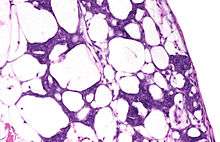Blastema

A blastema is a mass of cells capable of growth and regeneration into organs or body parts. Historically, blastemas were thought to be composed of undifferentiated pluripotent cells, but recent research indicates that in some organisms blastemas may retain memory of tissue origin.[1] Blastemas are typically found in the early stages of an organism's development such as in embryos, and in the regeneration of tissues, organs and bone.[2]
Some amphibians and certain species of fish and two species of African spiny mice can produce blastemas as adults.[3] For example, salamanders can regenerate many organs after their amputation, including their limbs, tail, retina and intestine.[4] Most animals, however, cannot produce blastemas.
Limb Regeneration
When the limb of the salamander is cut off, a layer of epidermis covers the surface of the amputation site. In the first few days after the injury, this wounded epidermis transforms into a layer of signaling cells called the Apical Epithelial Cap (AEC), which has a vital role in regeneration. In the meantime, fibroblasts from the connective tissue migrate across the amputation surface to meet at the center of the wound. These fibroblasts multiply to form a blastema, the progenitor for a new limb.[5]
References
- ↑ Krag, Martin; Knapp, Dunja; Nacu, Eugen; Khattak, Shahryar; Maden4, Malcolm; Epperlein, Hans Henning; Tanaka, Elly M. (July 2009). "Cells keep a memory of their tissue origin during axolotl limb regeneration". Nature. 460 (7251): 60–65. doi:10.1038/nature08152. PMID 19571878. Retrieved February 2010. Check date values in:
|access-date=(help) - ↑ Tanaka, Elly (July 19, 2011). "The cellular basis for animal regeneration". Developmental Cell. 21 (1): 172–185. doi:10.1016/j.devcel.2011.06.016.
- ↑ Godwin, James (September 2014). "The promise of perfect adult tissue repair and regeneration in mammals: Learning from regenerative amphibians and fish". BioEssays. 36 (9): 861–871. doi:10.1002/bies.201300144.
- ↑ Wade, Nicholas (April 11, 2006). "Regrow Your Own". New York Times. Retrieved February 2010. Check date values in:
|access-date=(help) - ↑ Christensen RN, Tassava RA (February 2000). <216::AID-DVDY8>3.0.CO;2-8 "Apical epithelial cap morphology and fibronectin gene expression in regenerating axolotl limbs". Developmental Dynamics. 217 (2): 216–24. doi:10.1002/(SICI)1097-0177(200002)217:2<216::AID-DVDY8>3.0.CO;2-8. PMID 10706145. Retrieved 2013-04-09.
Further reading
- Becker, Robert O.; Gary Selden (1998). The Body Electric. Harper Paperbacks. ISBN 0-688-06971-1.